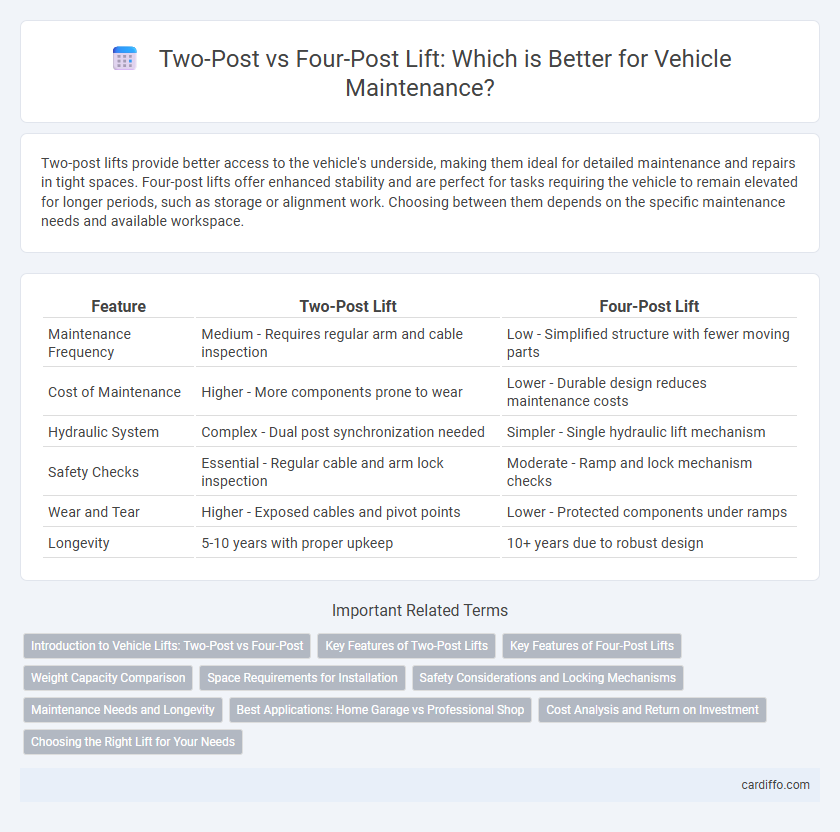Two-post lifts provide better access to the vehicle's underside, making them ideal for detailed maintenance and repairs in tight spaces. Four-post lifts offer enhanced stability and are perfect for tasks requiring the vehicle to remain elevated for longer periods, such as storage or alignment work. Choosing between them depends on the specific maintenance needs and available workspace.
Table of Comparison
| Feature | Two-Post Lift | Four-Post Lift |
|---|---|---|
| Maintenance Frequency | Medium - Requires regular arm and cable inspection | Low - Simplified structure with fewer moving parts |
| Cost of Maintenance | Higher - More components prone to wear | Lower - Durable design reduces maintenance costs |
| Hydraulic System | Complex - Dual post synchronization needed | Simpler - Single hydraulic lift mechanism |
| Safety Checks | Essential - Regular cable and arm lock inspection | Moderate - Ramp and lock mechanism checks |
| Wear and Tear | Higher - Exposed cables and pivot points | Lower - Protected components under ramps |
| Longevity | 5-10 years with proper upkeep | 10+ years due to robust design |
Introduction to Vehicle Lifts: Two-Post vs Four-Post
Two-post lifts provide vertical vehicle lifting using two sturdy posts, making them ideal for tasks requiring full undercarriage access and space efficiency in smaller workshops. Four-post lifts feature four support columns and offer greater stability, often used for vehicle storage and alignment jobs with easier drive-on ramps. Choosing between two-post and four-post lifts depends on workshop space, lifting capacity, and specific maintenance needs.
Key Features of Two-Post Lifts
Two-post lifts feature a compact design with two vertical posts supporting hydraulic or electric arms, enabling easy access to vehicle undercarriages for comprehensive maintenance tasks. Their adjustable arms accommodate various vehicle sizes, making them ideal for both small garages and professional workshops focused on efficiency and space-saving. Typically, two-post lifts offer higher lift heights and improved ground clearance compared to four-post lifts, enhancing mechanic accessibility during repairs.
Key Features of Four-Post Lifts
Four-post lifts offer enhanced vehicle stability and weight distribution, making them ideal for wheel alignment and undercarriage maintenance. Their stationary runways allow for easier loading and unloading of vehicles, supporting heavier weight capacities typically up to 30,000 pounds. The design also enables technicians to perform longer-term storage or repairs without obstructing access to the vehicle's underside.
Weight Capacity Comparison
Two-post lifts typically offer weight capacities ranging from 7,000 to 15,000 pounds, making them suitable for lighter vehicles and standard automotive work. Four-post lifts generally provide higher weight capacities, up to 18,000 pounds or more, accommodating heavy-duty trucks and large SUVs with increased stability. Choosing between a two-post and four-post lift depends heavily on the required lifting capacity and the type of vehicles serviced in the maintenance facility.
Space Requirements for Installation
Two-post lifts require significantly less floor space compared to four-post lifts, making them ideal for smaller workshops or garages with limited room. Four-post lifts need a larger footprint due to their extended length and width, which accommodates vehicle ramps and increased stability. Choosing between the two depends largely on available installation space and workflow requirements.
Safety Considerations and Locking Mechanisms
Two-post lifts feature mechanical safety locks and automatic locking systems that engage at various heights, ensuring secure vehicle support during maintenance. Four-post lifts incorporate ramps and wheel stops combined with robust locking mechanisms that reduce the risk of accidental movement or slippage. Choosing the appropriate lift involves evaluating load capacity, stability requirements, and the lift's intrinsic safety features to mitigate hazards effectively.
Maintenance Needs and Longevity
Two-post lifts require regular inspection of cables, hydraulic lines, and safety locks to ensure optimal functionality and safety, while four-post lifts demand routine checks of the drive systems and chassis for balanced wear and tear. Maintenance for two-post lifts tends to be more frequent due to their exposed components, but they allow easier access for repairs compared to the more enclosed mechanisms of four-post lifts. Four-post lifts generally boast enhanced longevity with fewer mechanical stress points, but proper maintenance of the rollers and bridges is critical to prevent premature wear and ensure long-term durability.
Best Applications: Home Garage vs Professional Shop
Two-post lifts are ideal for professional shops due to their ability to provide full access to the vehicle's undercarriage and facilitate tire and brake service, making them suitable for frequent, heavy-duty use. Four-post lifts excel in home garages by offering a stable platform for vehicle storage, alignment services, and maintenance with easier vehicle entry and exit. Choosing between the two depends on the intended application, workspace size, and type of maintenance tasks performed.
Cost Analysis and Return on Investment
Two-post lifts generally have a lower initial cost compared to four-post lifts, making them a budget-friendly option for many automotive service shops. Although four-post lifts come with a higher upfront expense, their increased stability and versatility often lead to better utilization rates and longer equipment lifespan, which can improve overall return on investment. Evaluating factors such as maintenance costs, operational efficiency, and expected usage frequency is crucial for optimizing the cost-benefit balance between these lifts.
Choosing the Right Lift for Your Needs
Selecting between a two-post lift and a four-post lift depends on your specific maintenance requirements and space availability. Two-post lifts offer greater accessibility for undercarriage inspections and repairs, making them ideal for smaller garages with limited floor space. Four-post lifts provide enhanced stability and load capacity, which suits heavy-duty vehicle maintenance and storage needs.
Two-Post Lift vs Four-Post Lift Infographic

 cardiffo.com
cardiffo.com